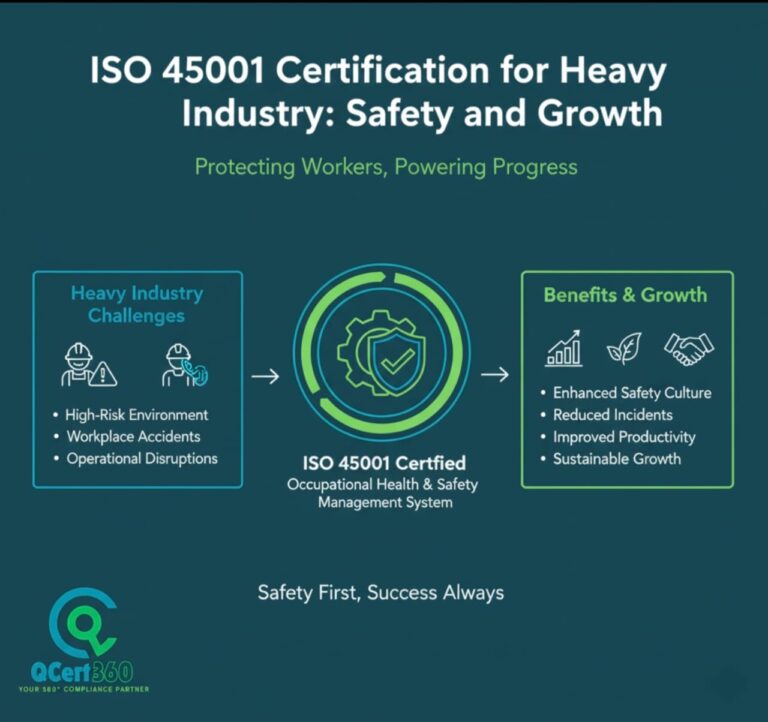
In heavy industries—think mining, steel, oil and gas, shipbuilding, and large-scale manufacturing—the margin for error is razor-thin. A single safety lapse can mean not just lost lives but halted production, penalties, lawsuits, and reputational damage that takes years to recover from. That’s where ISO 45001 certification steps in. It’s more than a compliance badge; it’s a system that helps organizations protect their people while unlocking new business growth.
Let’s break down why ISO 45001 certification standard is reshaping heavy industries and how companies that embrace it are finding themselves not only safer but also more competitive.
What ISO 45001 Certification Means in Heavy Industry
ISO 45001 is the international standard for occupational health and safety management systems. It provides a structured framework to manage risks, reduce workplace incidents, and create a culture of prevention.
For heavy industries, where hazards like machine injuries, toxic exposure, fire, or structural failures are common, ISO 45001 goes beyond traditional compliance. It integrates safety into the DNA of operations, making it part of how work gets done—not an afterthought.
This certification demonstrates that a company is serious about safety, meeting global best practices, and ensuring that workers go home safe every day.
Why Heavy Industry Businesses Need ISO 45001 certification Now
Here’s the reality: heavy industries are under increasing scrutiny. Clients, contractors, and investors demand more proof that safety isn’t just being promised but systematically managed.
Key benefits include:
- Reduced accidents and downtime – Workplace incidents cost millions in lost hours and compensation. ISO 45001 certification implementation cuts those risks dramatically.
- Stronger legal compliance – Heavy industries face strict regulations. Certification provides a compliance framework that keeps audits smooth.
- Winning contracts – Many large-scale tenders and projects require ISO 45001 certification of registration as a precondition.
- Improved workforce morale – Employees are more engaged and productive when they know safety is taken seriously.
- Long-term cost savings – Fewer accidents mean fewer claims, less disruption, and lower insurance premiums.
What this really means is that ISO 45001 certification compliance isn’t just about safety—it’s about growth, competitiveness, and resilience.
Real-World Case Study: Steel Manufacturer Secures Global Contract with ISO 45001 attestation
Take the example of a large steel manufacturer that was struggling with repeated workplace injuries. Not only did these incidents result in costly downtime, but the company also failed to qualify for a high-value international contract because they couldn’t show compliance with global health and safety standards.
By implementing ISO 45001, the business introduced stricter risk assessments, regular safety audits, and better employee training. Within 18 months, workplace incidents dropped by 45%. With a robust safety management system in place, the company reapplied for contracts and successfully secured a multi-million-dollar deal with a European construction firm.
The lesson: Occupational health & safety ISO certification isn’t just a safety measure—it’s a direct enabler of revenue opportunities.
Core Elements of ISO 45001 certification in Heavy Industry
To make it practical, ISO 45001 is built on key elements that translate perfectly to high-risk industries:
- Hazard Identification and Risk Control – From handling heavy machinery to dealing with hazardous materials, risks are mapped and mitigated before accidents occur.
- Worker Participation – Employees are not passive. They are actively involved in safety discussions, reporting hazards, and improving processes.
- Leadership Commitment – Senior management isn’t just signing papers; they lead safety from the top.
- Emergency Preparedness – Fire drills, evacuation planning, and accident simulations are built into daily operations.
- Continuous Improvement – Safety isn’t static. Companies must monitor, review, and update safety systems regularly.
This structured approach transforms safety from a checklist into a continuous cycle of improvement.
Growth Through ISO 45001 Certification
Some leaders still think of certification as a cost rather than an investment. But in heavy industries, the ROI is measurable:
- Tender Qualification – Many international tenders list ISO 45001 as mandatory. Without it, businesses are disqualified instantly.
- Investor Confidence – Investors are wary of companies with frequent accidents. Certification provides assurance of long-term stability.
- Operational Efficiency – Reduced downtime means smoother production schedules and stronger client trust.
Put simply, safety drives growth. A company that can prove it manages risks well is a company that clients want to work with.
ISO 45001 certification and Sustainability Goals
One of the most overlooked advantages of ISO 45001 is its direct link to sustainability and ESG objectives. Worker safety is not just an internal compliance matter—it’s a recognized pillar of responsible business worldwide. When a company demonstrates that it values the health, safety, and well-being of its workforce, it’s actively contributing to the “social” dimension of ESG, while also reinforcing good governance through systematic risk management.
Heavy industries, in particular, face intense scrutiny from regulators, investors, and global buyers. Beyond emissions or environmental performance, procurement teams now assess whether suppliers uphold high standards for occupational health and safety. ISO 45001 certification provides a verifiable framework for proving this commitment. It shows that an organization doesn’t simply talk about sustainability but has embedded safety practices into everyday operations.
By aligning with ISO 45001, heavy industry players do more than comply with legal obligations—they build trust. They signal to employees, partners, and clients that they are forward-thinking and reliable contributors to global supply chains. This alignment can open doors to international contracts, attract ESG-conscious investors, and strengthen brand reputation in markets where responsible sourcing is becoming the rule, not the exception.
Common Misconceptions about OHSAS 18001 certification in Heavy Industry
Despite the clear advantages, many heavy industry companies still hesitate to pursue ISO 45001 certification. Here are some common misconceptions and the reality behind them:
- “We already follow safety laws, so we don’t need ISO 45001.”
Meeting legal requirements is only the starting point. ISO 45001 builds a proactive, structured safety management system that identifies risks before they cause harm, going far beyond basic compliance. - “Certification is too expensive for us.”
While certification involves some investment, the cost of a single major accident, equipment downtime, or legal penalty can far exceed it. In reality, ISO 45001 often saves money by reducing incidents and insurance premiums. - “Our workers won’t adapt to new systems.”
ISO 45001 is designed around worker participation. Instead of creating resistance, it actively improves engagement by giving employees a voice in safety decisions. - “It’s only for large multinational companies.”
ISO 45001 applies to businesses of every size. Heavy industry SMEs often benefit the most, as certification helps them qualify for contracts that would otherwise be out of reach. - “Certification takes too much time and disrupts operations.”
Implementation can be phased in without disrupting production. In fact, companies often find that streamlined processes save time and reduce operational headaches in the long run.
ISO 45001 Implementation Challenges and Solutions
Like any major initiative, ISO 45001 certification for heavy industry comes with challenges. The standard sets high expectations, and integrating it into complex operations requires both planning and persistence. Here are the most common hurdles and practical ways to address them:
Resistance to Change – Employees and supervisors may feel that safety audits, checklists, or stricter reporting slow down production. This resistance can be overcome by involving employees in the design and rollout of safety systems, encouraging them to share feedback, and showing how improved safety protects their lives and livelihoods. When workers see they are part of the solution, adoption rates rise significantly.
Data Collection and Monitoring – Heavy industry generates massive volumes of operational data, but much of it goes underutilized. Paper-based records create delays, errors, and blind spots. Using digital tools to track incidents, inspections, and training makes compliance easier and more transparent. Mobile apps, dashboards, and automated alerts ensure issues are flagged early, preventing costly accidents. This also helps companies build evidence of compliance for audits and contracts.
Management Buy-In – Leadership teams often focus on financial metrics, so safety upgrades may initially look like a cost centre. Highlighting the financial and contract-winning benefits of ISO 45001 helps secure management support. Tangible outcomes like reduced accident claims, fewer work stoppages, and higher tender qualification rates make the investment hard to ignore.
Integration with Existing Systems – Many heavy industries already run ISO 9001 for quality or ISO 14001 for environmental management. Integrating ISO 45001 into existing frameworks can seem daunting. The solution is to align policies, documentation, and audits so systems reinforce rather than duplicate each other. This creates efficiency and avoids “audit fatigue” among employees.
Supply Chain Compliance – Contractors and suppliers often operate at different levels of safety maturity. Companies may struggle to ensure consistent standards across the supply chain. Clear safety clauses in contracts, coupled with supplier audits and training, help close this gap and prevent weak links that could undermine certification.
Cultural Differences Across Sites – For companies with multiple plants or sites, local practices may vary widely. Standardizing health and safety culture across all facilities requires strong leadership messaging, regular cross-site training, and the sharing of best practices. Establishing safety as a non-negotiable value makes adoption more uniform.
Resource Allocation – Smaller departments or sites within large heavy industry operations may lack the dedicated resources for compliance. A phased approach—starting with high-risk areas and expanding gradually—ensures progress without overwhelming the system.
Companies that commit to implementation often find that the benefits outweigh the hurdles within the first year. Reduced downtime, stronger safety records, and better tender outcomes quickly turn ISO 45001 into a growth driver, not just a compliance checkbox.
ISO 45001 Implementation Challenges and Solutions
At Qcert360, we’ve worked with heavy industries worldwide to streamline their ISO 45001 journey. From initial gap assessments to full certification support, we help companies avoid common pitfalls and build systems that not only pass audits but also strengthen day-to-day operations.
Our approach is hands-on: engaging workers, training leadership, and aligning certification with business growth goals. The result is not just a certificate on the wall but a system that protects people and wins business.
Conclusion
ISO 45001 certification is no longer optional for heavy industries. It’s a strategic requirement that safeguards workers, builds resilience, and directly drives growth by opening doors to global contracts.
For companies serious about safety and expansion, the path is clear: invest in ISO 45001 today, and the payoff will extend far beyond compliance. Contact Qcert360 for more details about ISO 45001 consulting service near you today.
FAQs about ISO 45001 Certification for Heavy Industry
- What is ISO 45001 certification?
It’s the global standard for occupational health and safety management systems, designed to reduce risks and prevent workplace incidents. - Why is ISO 45001 certification important for heavy industries?
Because the risks are higher, certification provides a structured system to protect workers and win contracts. - How long does it take to get to become ISO 45001 certified company?
On average, 2–4 months, depending on company size, complexity, and readiness. - Is ISO 45001 certification mandatory for my company?
Not always legally, but many clients and tenders require it as a prerequisite. - What are the costs involved to obtain ISO 45001 certification?
Costs vary by company size, but the investment is usually recovered through fewer accidents and new business opportunities. - How does ISO 45001 reduce accidents?
By proactively identifying risks, engaging employees, and implementing preventive controls. - Can ISO 45001 integrate with other ISO standards?
Yes, it aligns well with ISO 9001 (quality) and ISO 14001 (environmental). - What role do employees play in ISO 45001 registration?
Workers are actively involved in reporting risks, participating in safety decisions, and improving systems. - Does certification help in winning international tenders?
Yes, many large contracts list ISO 45001 as mandatory for qualification. - How often does ISO 45001 need to be renewed?
Certification is valid for three years, with annual surveillance audits to ensure compliance.
Our Services
ISO Standards
- ISO 9001 Certification
- ISO 14001 Certification
- ISO 45001 Certification
- ISO 22000 Certification
- ISO 17025 Certification
- ISO 27001 Certification
- ISO 13485 Certification
- ISO 20000-1 Certification
- ISO 41001 Certification
- ISO 22716 Certification
- ISO 50001 Certification
- ISO 22301 Certification
- ISO 29993 Certification
Product Certifications
Other international standards
- FSSC 22000 Certification
- HIPAA
- HACCP Certification
- SA 8000 Certification
- GMP Certification
- GDPR
- GDP Certification
- GLP Certification
- Certificate of Conformity
QCert360 provides a wide range of services including ISO certification, audit support, compliance consulting, and training. They specialize in helping businesses achieve global standards and certifications like ISO 9001, ISO 27001, ISO 14001, and many others. Their team ensures a seamless experience from consultation to certification, supporting clients at every stage.
The time it takes to achieve certification can vary depending on the complexity of the standard and the readiness of your organization. On average, it takes about 3 to 6 months. QCert360 works closely with clients to streamline the process, ensuring that all requirements are met efficiently and within a reasonable timeline.
QCert360 is a trusted partner with years of experience in helping businesses obtain international certifications. Their expert consultants provide tailored solutions, ensuring your organization not only meets but exceeds industry standards. With a customer-centric approach, they focus on offering end-to-end support to simplify the certification journey.
QCert360 serves a wide range of industries including manufacturing, healthcare, information technology, education, and services, among others. They customize their certification solutions to meet the unique requirements of each industry, ensuring relevance and compliance with global standards.
Yes, QCert360 provides ongoing support even after certification. They offer services like surveillance audits, recertification guidance, and consultancy to help maintain and improve your certification status. Their team ensures that your organization stays compliant and up-to-date with any changes in certification standards.
Getting started with QCert360 is simple. You can contact them via their website to request a consultation. Their team will assess your needs, discuss the best certification options for your business, and outline the steps involved. From there, they’ll guide you through the entire process, ensuring you’re prepared for certification.
QCert360 stands out due to its customer-focused approach, industry expertise, and comprehensive service offerings. Their team doesn’t just help you obtain certification but works to ensure your organization thrives in compliance with international standards. They also offer personalized consultation, making the process smoother and more efficient, ensuring long-term success for your business.
The cost of certification varies depending on factors such as the type of certification, the size and complexity of your organization, and the specific industry requirements. QCert360 offers competitive pricing and provides tailored quotes based on your unique needs. They ensure transparency and work with you to find the most cost-effective solution for your certification goals.
Yes, QCert360 offers internal audit services to help assess and improve your organization’s processes. Their expert auditors conduct thorough reviews of your systems and operations to ensure they meet required standards. They also provide actionable recommendations to help enhance efficiency and compliance, making sure you’re fully prepared for external audits.
If your organization doesn’t pass an audit or certification assessment, QCert360 works with you to understand the reasons for non-compliance and provides support to rectify the issues. They offer guidance on corrective actions and help you prepare for a re-assessment. Their goal is to ensure your organization meets the necessary standards for certification, and they will be by your side to make the process as smooth as possible.


